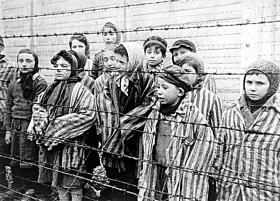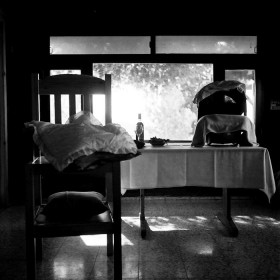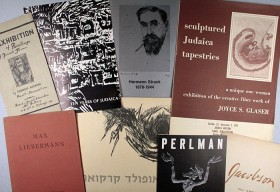
Surviving children in the main concentration camp, Auschwitz. This still from documentary footage shot by Alexander Voronzow shows Tomasz Szwarz, Alicja Gruenbaum, Solomon Rozalin, Gita Sztrauss, Wiera Sadler, Marta Wiess, Boro Eksztein, Josef Rozenwaser, Rafael Szlezinger, Gabriel Nejman, Gugiel Appelbaum, Mark Berkowitz, Pesa Balter, Rut Muszkies, Miriam Friedman, and Miriam and Eva Mozes. Licensed for the public domain by the United States Holocaust Memorial Museum.
Seventy years ago to this day, the Soviet Army liberated the death camps Auschwitz I and II. Almost ten years ago, the anniversary was designated International Holocaust Remembrance Day. Although I’ve been reflecting on representations of the Holocaust in art, literature, and philosophy for many years, I remain irritatingly little affected by today’s date, January 27. In most European countries, official events will once again collectively recall that breach of civilization and commemorate those who were systematically murdered. So too will Germany. Here, the decision to officially commemorate the victims of the Holocaust on this day was reached in 1996—not least because → continue reading

Before the circumcision ceremony: the godfather’s chair and the infant carrier with Yair © photo: Birgit Glatzel
Naomi converted to Judaism six years ago. Shortly afterwards she became pregnant, went to live with her boyfriend Avishay in Tel Aviv, and gave birth there to a son, Yair, who was circumcised as Jewish law demands. In the meantime the couple has moved to Berlin and separated. Naomi recently showed me the photos she took at the ceremony and we talked about her thoughts on ritual circumcision, then and now.
Mirjam: What was your very first thought when you heard you were expecting a son?
Naomi: I was delighted. For Avishay and I, it was also clear from the get-go that we’d have him circumcised. But, to be honest, we neither gave the matter much thought nor prepared for it in any way. It is Jewish tradition to → continue reading

Gray literature held by the library, Gross Family Collection © Jewish Museum Berlin, Photo: Lea Weik
The library of the Jewish Museum Berlin is growing day by day. Since early 2014, this has been particularly noticeable in the Jewish visual and applied arts section, which currently stocks about 10,000 media objects (books, journals, non-book media, etc.). As part of the framework of a project funded by the DFG (German Research Foundation), which I have been working on for the past year, our team has had the opportunity to make essential acquisitions and to close existing gaps in this area. Further expansion is planned—and will take us another big step towards our goal of establishing a research library for Jewish art and cultural history.
Before the first Jewish visual and applied arts publications arrived at the library, there were many tasks to be performed: first and foremost, to settle the question, → continue reading


